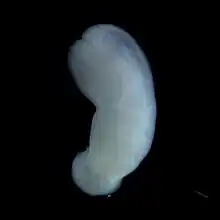| Malacobdella | |
|---|---|
 | |
| Malacobdella sp. | |
| Scientific classification | |
| Domain: | Eukaryota |
| Kingdom: | Animalia |
| Phylum: | Nemertea |
| Class: | Enopla |
| Order: | Hoplonemertea |
| Family: | Malacobdellidae Blanchard, 1847 |
| Genus: | Malacobdella Blainville, 1827 |
Malacobdellidae is a monogeneric family within the phylum Nemertea. It is included with the order Hoplonemertea within the class Enopla (formerly in monotypic order Bdellonemertea of the same class).[1]
Morphology
The family, as well as its sole genus Malacobdella, is characterized by a posterior ventral sucker and a proboscis lacking a stylet.[2] As in other Hoplonemertea, the lateral longitudinal nerve cord is located internal to the body wall muscles, in the mesenchyme.[3]
Ecology
Members of Bdellonemertea are all commensal, living in the mantle cavities of bivalves.[4] The only non-marine and non-bivalve hosted species, Malacobdella auriculae, is doubtful. It was described in 1847 by Émile Blanchard on the basis of a single drawing of his colleague and probably wasn't even a nemertean.[5] Malacobdella feed on small food particles that are brought into the mollusk's ctenidia.
References
- ↑ Tholleson, M. and Norenburg, J.L. (2003). "Ribbon worm relationships: a phylogeny of the phylum Nemertea". Proceedings of the Royal Society B 270: 407-415.
- ↑ Gibson, R. (1972). Nemerteans. Hutchinson & Co. Ltd. ISBN 0-09-111990-1.
- ↑ Brusca, R.C. and Brusca, G.J. (2003). "Phylum Nemertea: The Ribbon Worms". Invertebrates (2 ed.) Sinauer Associates, Inc. p.329. ISBN 0-87893-097-3.
- ↑ Pechenik, J.A. (2005). "The Nemertines". Biology of the Invertebrates (5 ed.) McGraw-Hill. p. 205. ISBN 0-07-234899-2.
- ↑ Kozloff, E. N. (1991). "Malacobdella siliquae sp. nov. and Malacobdella macomae sp. nov., commensal nemerteans from bivalve molluscs on the Pacific coast of North America". Canadian Journal of Zoology. 69 (6): 1612–1618. doi:10.1139/z91-225.